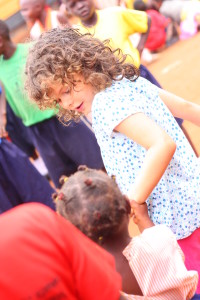Catch earlier posts here on Solitude, Prayer, Meditation and Contemplation, and Simplicity. Find initial concepts for this important series here.

Part of what I love about living in Africa: opportunities for my kids to serve are everywhere. As in, next door. I admit to being concerned about this when we landed in the U.S. six months ago. How was I going to draw a dotted line for my kids from compassion in Uganda to compassion in Colorado?
Awesome thing is, there are opportunities to serve–in really fun ways–in every zip code, from Salvation Army bell-ringers, to running a booth at the Fall Festival for the community, to the military family across the street whose dad’s deployed. Serving transforms our homes into aircraft carriers as its members are nurtured, then launched into the community.
The question often becomes how much we push our kids
into what they don’t want to do.
I ran into this personally with a library storytime my kids started in an impoverished neighborhood close to our home. Though they tended to love reading the stories and singing the songs, sometimes the kids in the neighborhood made fun of them, dumping out their water bottles and being otherwise obnoxious (which you can expect when you’re serving kids who’ve had hard times growing up).

This required some discernment as I watched for signs of when to push for the sake of perseverance and love; when to ease up for the sake of protecting my kids’ hearts from bitterness and joylessness–and how to add to the “carrot” (the reward). My kids took turns having a week off, and we always went for kasooli, an inexpensive local treat, afterward. We talked through strategies to help them deal with ornery kids. And at then end of their service, the sponsor of the library was very honoring to them. It left a great taste in their mouths—but if things had gone on much longer, I would have been okay with bowing out.
Valerie Hess and Marti Garlett point out, “When service is out of balance, it moves us away from, rather than toward, God. It drains rather than restores.” They wisely quote (–which should be tattooed on my person somewhere, I think–),
St Theresa said that to give our Lord a perfect service, Martha and Mary must combine….Thousands of devoted men and women today believe that the really good part is to keep busy, and give themselves no time to take what is offered to those who abide quietly with Christ, because there seem such a lot of urgent jobs for Martha to do. The result of this can only be a maiming of their human nature, exhaustion, loss of depth and of vision, and it is seen in the vagueness and ineffectuality of a great deal of the work that is done for God. —Evelyn Underhill*
I reward service pretty liberally with my kids, and give them healthy breaks. I love it when they look forward to service and when they volunteer for it. Grant it, service is its own reward! Yet we also want to associate serving with delight. God inlaid His own reward system in us, washing our body systems with endorphins when we love on others. And He promises rewards in the future, too. So provide some hot cocoa for your Salvation Army bell-ringers, or grab a treat in the store after—and consider that as their chore for the day.
Self-Righteous Service vs. True Service
Hess and Garlett help clarify the nature of the kind of service we want to develop in our kids, in these concepts from Richard Foster (which I’ve placed in a table):*
| SELF-RIGHTEOUS SERVICE | AUTHENTIC SERVICE |
| prefers the big, sparkly jobs | finds it almost impossible to differentiate the small from the large |
| calculates results and expects gratitude, compensation | finds happiness in service itself |
| picks and chooses whom to serve, mostly because of image | indifferent to an audience; almost never notices when others watch |
| blown around by moods and impulses | gives steadfastly because there is a need |
| short-lived | ongoing lifestyle |
| puts others in my debt; builds me up as the giver | builds community; subtle and unpretentious, putting no one under obligation |
| needs to know people see and appreciate the effort (with proper religious modesty, of course) | fine with hiddenness; doesn’t shy away from or look for praise |
THE KEY: Training our kids’ eyes to see opportunities for humble, happy service everywhere. Service pries our fingers from our own agenda, and primes our hearts for “Here am I! Send me!”
A few more ideas:
- Loads of practical ideas: Check out this post for 25 Low-prep Ideas to Teach Kids Gratitude, and this one on 100+ Ways for Your Family to Make a Difference. Other sites to check out include DoSomething.org and PointsofLight.org. Offer your kids a few ideas, helping them catch the vision and allowing them to talk about what sounds fun. Some of the best ideas for service are those our kids generate themselves from the need around them!
- Consider the “Judea, Samaria, and the ends of the earth” philosophy. What can you do to serve members of your own family? Then, expanding your “circle”, for your school, community or church? What about internationally?
- For family devotions one night, consider a foot-washing ceremony, and have one of your kids read John 13:12-20 and its final message: If you know these things, blessed are you if you do them. (Here’s a song from Seeds Family Worship so you can memorize it together.) As a family, talk about whether your kids feel like it really is better to give than receive (but acknowledge we all need to receive). This page from Focus on the Family’s Kids of Integrity has even more great ideas for devotions, object lessons, and service.
- Don’t confine kids’ service at home to chores. I still remember as a mom of toddlers watching a preteen hop up an immediately help his mom with a younger sibling. I thought, I want kids who will respond to service whenever they’re asked. Rather than shielding your kids from dinner duty or carrying in groceries, frequently request their assistance in all forms of service. It won’t all be fireworks–but help them get excited about making Dad’s favorite cookies, or have a contest to see who can hit the hamper with even their sibling’s dirty clothes. Remember, we’re training them to be the chief servant in their own homes someday.
- Beyond doing for others, as in #1, consider other forms of serving: praying, spending time with someone, giving of our own money (tithing), showing hospitality (even at a cafeteria lunch table or to another kid at the playground). The idea: Service isn’t a project; it’s a way of being, and of seeing the world. What else will your kids think of?
Like this post? You might like
- On Giving our Kids the Gift of Hard Work
- 10 Prayer Tools and Printables for Families
- Spiritual Disciplines for Real Families Series:
- 5 Surprising Prayers for My Kids
- 31 Scriptures to Pray for Your Kids (free printable)
*Habits of a Child’s Heart: Raising Your Kids with the Spiritual Disciplines.







